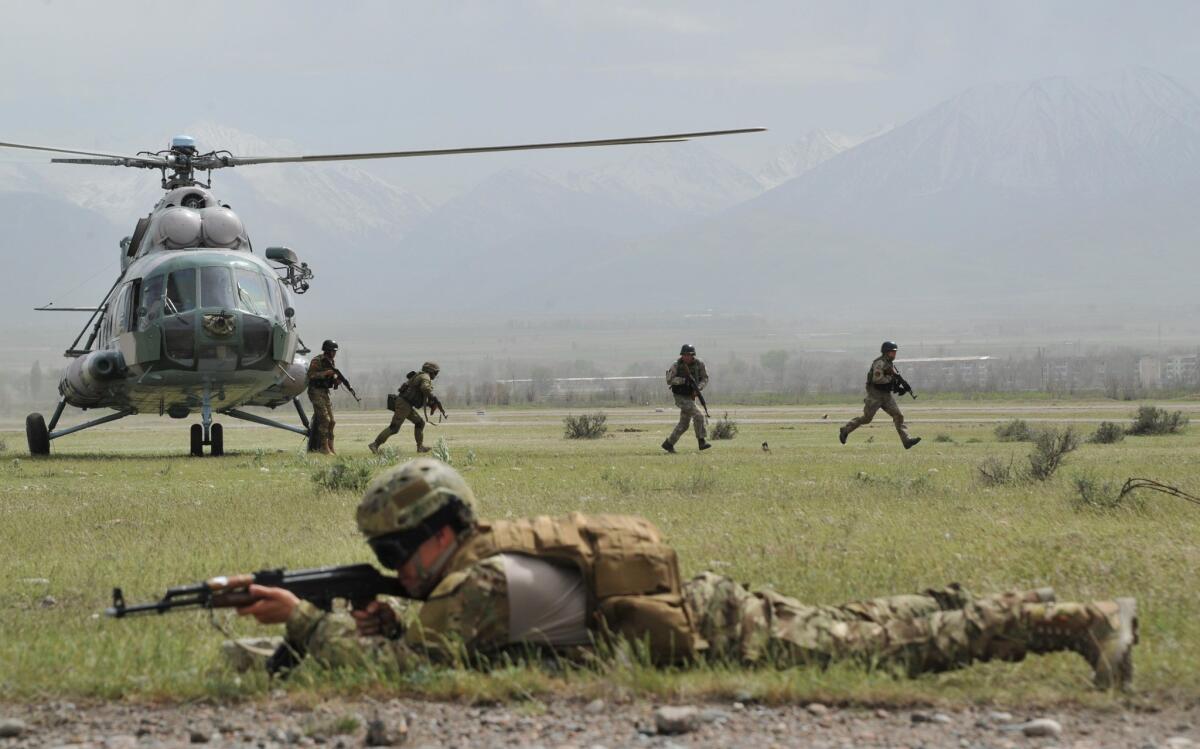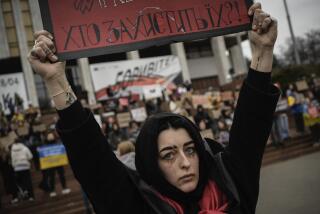Russia and Western nations staging rival air combat exercises

Special forces soldiers of the Shanghai Cooperation Organization, which includes Russia, deploy during military exercises last month in Kyrgyzstan.
Russian President Vladimir Putin ordered four days of air combat readiness testing on Monday, the third major military exercise staged by the Kremlin in as many months.
The drills will involve 12,000 troops, 250 aircraft and nearly 700 artillery pieces and other heavy weaponry and include cruise missile strikes at an imaginary enemy target at a Siberian firing range, the Tass news agency reported.
The surprise test of the Russian Central Military District’s ability to defend against an air invasion coincides with NATO-led military exercises over the Arctic region that are part of the Western alliance’s response to Russia’s stepped-up maneuvers over the Baltic and Northern European regions.
About 100 fighter jets and 4,000 military personnel from the United States and eight European countries began exercises over the Arctic on Monday, Norwegian Brig. Gen. Jan Ove Rygg announced in a statement from Oslo.
The Western maneuvers that will run through June 5 also include live-fire exercises. They will involve six member states of the North Atlantic Treaty Organization -- the U.S., Germany, Britain, France, Norway and the Netherlands -- as well as non-NATO states Sweden, Finland and Switzerland.
Russia’s Northern Fleet carried out massive drills in the Barents Sea in March, involving 40,000 soldiers and sailors, more than 150 combat aircraft and dozens of warships.
Russian naval forces last week completed 10 days of joint operations with Chinese vessels in the Mediterranean Sea, the first-ever exercises by the Asian giants in the strategic waters between southern Europe, Northern Africa and the Middle East. Neither Russia nor China has coastline in the Mediterranean, and the war games were seen as another flexing of military muscle in defiance of NATO.
There have also been smaller exercises led by Russia in recent months to test interoperability with armed forces in allied Central Asian states, including Kyrgyzstan and Tajikistan.
NATO and the United States have likewise conducted bilateral training exercises with former Soviet republics in recent weeks, including Georgia and Ukraine.
Russia’s National Security Committee last year rewrote the country’s defense doctrine, identifying NATO as the No. 1 threat to the security of the Russian Federation.
Putin has also lashed out at the Western military bloc for its incursion into what he considers Russia’s traditional sphere of influence with its induction of former Soviet states Latvia, Lithuania and Estonia, and defense alliances with Eastern European states such as Poland that were dominated by the Kremlin during the Cold War.
Putin sent troops into Ukraine’s Crimea region in February 2014, after a Kremlin-compliant president, Viktor Yanukovich, was toppled from power by a three-month pro-European rebellion. The Kremlin leader has cast Ukraine’s westward shift in its political and security alliances as U.S.-led aggression against Russia aimed at destabilizing Putin’s regime.
NATO, the U.S., the European Union and the new leadership in Kiev, the Ukrainian capital, accuse Russia of deploying fighters and heavy weapons into eastern Ukraine to bolster a separatist rebellion there that has taken more than 6,100 lives in the past 13 months.
Putin denies he has been backing the pro-Russia insurgents, claiming those Russians fighting in the neighboring country are there as “volunteers.”
Follow @cjwilliamslat for the latest international news 24/7
More to Read
Start your day right
Sign up for Essential California for news, features and recommendations from the L.A. Times and beyond in your inbox six days a week.
You may occasionally receive promotional content from the Los Angeles Times.







